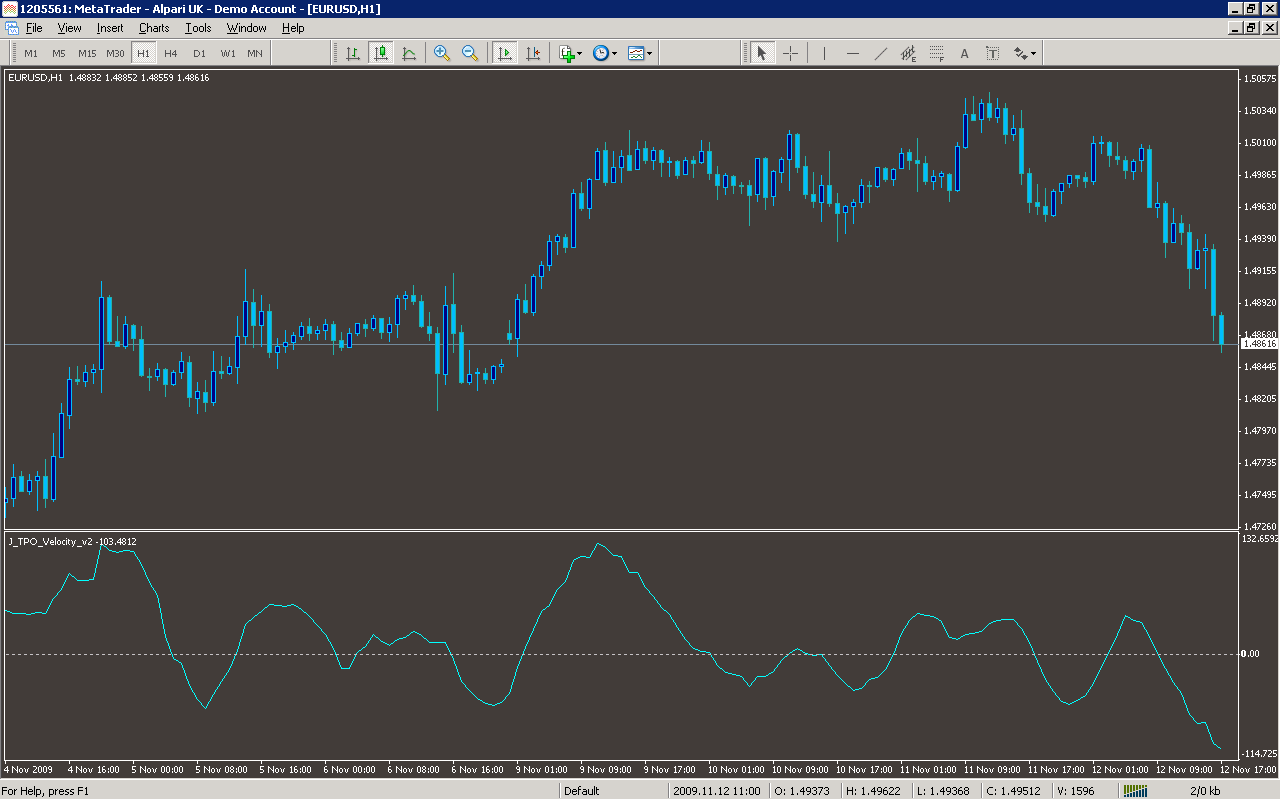//+------------------------------------------------------------------+
//| J_TPO_Velocity.mq4 |
//| Copyright © 2005, |
//| |
//+------------------------------------------------------------------+
//+----------------------------------------------------------------------------------+
//| J_TPO_Velocity is a modification by Matt Kennel of J_TPO_Clean. |
//| J_TPO is in its original form, an oscillator between -1 and +1, |
//| a nonparametric statistic quantifying how well the prices are ordered |
//| in consecutive ups (+1) or downs (-1) or intermediate cases in between. |
//| |
//| J_TPO_Velocity takes that value and multiplies it by the range, highest high |
//| to lowest low in the period (in pips), divided by the period length. |
//| Therefore, J_TPO_Velocity is a rough estimate of "velocity" as in |
//| "pips per bar". Positive of course means going up and negative means going down.|
//| |
//| J_TPO_Velocity thus crosses zero at exactly the same time as J_TPO, but hte |
//| absolute magnitude is different. |
//| |
//| Matt (mbkennel@gmail.com) |
//| |
//| This code is released under the terms of the GNU General Public License V2 |
//+----------------------------------------------------------------------------------+
#property copyright "Copyright © 2005"
#property link "www.metatrader.org"
//----
#property indicator_separate_window
#property indicator_buffers 1
#property indicator_color1 DodgerBlue
//---- input parameters
extern int Len=14;
//---- buffers
double ExtMapBuffer1[];
//+------------------------------------------------------------------+
//| Custom indicator initialization function |
//+------------------------------------------------------------------+
int init()
{
//---- indicators
SetIndexStyle(0,DRAW_LINE);
SetIndexBuffer(0, ExtMapBuffer1);
//----
return(0);
}
//+------------------------------------------------------------------+
//| J_TPO indicatop |
//+------------------------------------------------------------------+
int start()
{
int limit;
int counted_bars=IndicatorCounted();
//---- check for possible errors
if(counted_bars<0) return(-1);
//---- last counted bar will be recounted
if(counted_bars>0) counted_bars--;
limit=MathMin(Bars-counted_bars-Len,Bars-Len-1);
if (Len < 3)
{
Print("J_TPO_B: length must be at least 3");
return(0); //
}
for(int i=limit; i>=0; i--)
{
ExtMapBuffer1[i]=J_TPO_value(Close,Len,i) * Range(Len,i)/Len;
}
//---- done
return(0);
}
//+------------------------------------------------------------------+
double Range(int Len, int shift)
{
// Return the range between highest and lowest of Len
// bars, starting at shift, measured in pips.
double H=High[Highest(NULL,0,MODE_HIGH,Len,shift)];
double L=Low[Lowest(NULL,0,MODE_LOW,Len,shift)];
//----
return((H-L)/Point);
}
//+------------------------------------------------------------------+
//| |
//+------------------------------------------------------------------+
double J_TPO_value(double input[], int Len, int shift)
{
//
// compute the J_TPO function on input[shift], looking back up to Len data previous
//
double value, normalization, Lenp1half;
double accum, tmp, maxval;
int j, maxloc, m;
double arr1[], arr2[], arr3[];
bool flag;
accum=0;
//----
ArrayResize(arr1,Len+1);
ArrayResize(arr2,Len+1);
ArrayResize(arr3,Len+1);
//----
for(m=1; m<=Len; m++)
{
arr2[m]=m;
arr3[m]=m;
arr1[m]=input[shift+Len-m];
}
// sort arr1[] in ascending order, arr2[] is the permutation index
// Note, this is a poor quadratic search, and will not scale well with Len
for(m=1; m<=(Len-1); m++)
{
// find max value & its location in arr1 [m..m+Len]
maxval=arr1[m];
maxloc=m;
for(j=m+1; j<=Len; j++)
{
if (arr1[j] < maxval)
{
maxval=arr1[j];
maxloc=j;
}
}
// Swap arr1[m] with its max value
// amd similarly for arr2.
tmp=arr1[m];
arr1[m]=arr1[maxloc];
arr1[maxloc]=tmp;
tmp=arr2[m];
arr2[m]=arr2[maxloc];
arr2[maxloc]=tmp;
}
// arr3[1..Len] is nominally 1..m, but this here adjusts for
// ties.
m=1;
while(m < Len)
{
// Search for repeated values.
j=m + 1;
flag=true;
accum=arr3[m];
while(flag)
{
if (arr1[m]!=arr1[j])
{
if ((j - m) > 1)
{
// a streak of repeated values was found
// and so replace arr3[] for those with
// its average
accum=accum/(j - m);
for(int n=m; n<=(j-1); n++)
arr3[n]=accum;
}
flag=false;
}
else
{
accum+=arr3[j];
j++;
} // if
} // while flag
m=j;
} // while (Len > m)
// This is the real guts of the J_TPO
// it is a simple statistic to see if the ranks, when applied in sorted order are
// "correlated" with 1..Len, a simple cross correlation of ranks.
// so if they are sorted then this gives 1, and if they are anti-sorted they give -1
// and similarly for intermediate values.
normalization=12.0/(Len*(Len-1)*(Len+1));
Lenp1half=(Len + 1) * 0.5;
//----
for(accum=0,m=1; m<=Len; m++)
{
// Print("m="+m+"Arr2[m] ="+arr2[m]+" arr3[m]="+arr3[m]);
accum+=(arr3[m] - Lenp1half) * (arr2[m] - Lenp1half);
}
value=normalization * accum;
// Print("JTPO_B: accum = "+accum+" norm = "+normalization);
return(value);
}
//+------------------------------------------------------------------+
Sample
Analysis
Market Information Used:
Series array that contains the highest prices of each bar
Series array that contains the lowest prices of each bar
Indicator Curves created:
Implements a curve of type DRAW_LINE
Indicators Used:
Custom Indicators Used:
Order Management characteristics:
Other Features:
